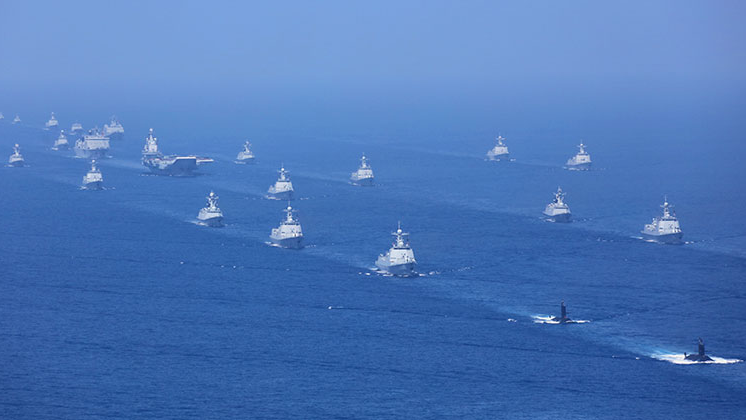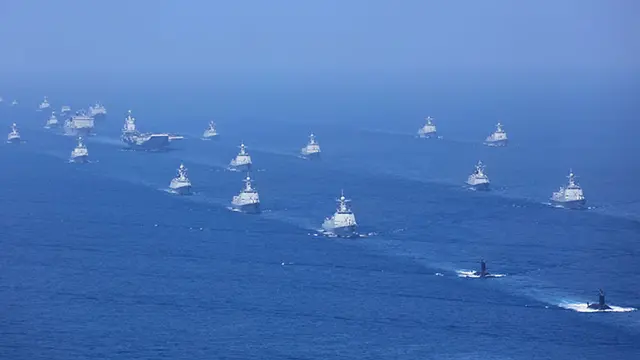
Aircraft carrier Liaoning, submarines, vessels and fighter jets take part in a review in the South China Sea, April 12, 2018. /Xinhua
Editor's note: Hamzah Rifaat Hussain is a former visiting fellow at the Stimson Center in Washington, and currently serves as assistant researcher at the Islamabad Policy Research Institute (IPRI) in Pakistan. The article reflects the author's opinions and not necessarily the views of CGTN.
The warm waters of the South China Sea have once again witnessed a rise in tensions with another addition to U.S. maritime activities posing an existential threat to Beijing.
The dual U.S. aircraft carrier operations of the Kanagawa prefecture based USS Ronald Reagan and the USS Nimitz have entered the region for joint operations. The unusual aspect about these latest deployments however, is that there are currently three carriers in the Western Pacific. The last time two carriers were deployed in the South China Sea was in September 2014 when the USS George Washington and the USS Carl Vinson Carrier Strike Group operated in tandem.
Either way, this latest development has resulted in China becoming increasingly more encircled with stated aims of operational opacity and events leading up to the deployment highlighting the palpability and imminence of the threat.
In May this year, U.S. Air force B-1 bombers undertook missions in the sea with the aim of sending a message to the wider target audience that the United States will maintain a visible presence in the region with assurances provided to allies that mutual interests on the freedom of navigation in the sea will be protected.
Similar rationales are being cited once again with claims of supporting a "free and open Indo-Pacific." The reality however, is starkly different. The strategy is based on engulfment where for the first time in 16 years, the U.S. Air Force initially withdrew the B-1 bombers from the island of Guam in April 2020 which acted as a key deterrent towards American adversaries. A month later, the very same B-1 bombers were sent back to the island with four B-1s carrying a penetration and fragmentation warhead capable of destroying the adversary's warships. No specifications of the time frame on how long the deployment would hold were given with the U.S. Air Force adopting a strategy of operational unpredictability.
The presence of opacity, unpredictability and lethal payloads are clear causes for alarm in the South China Sea with the sudden withdrawal of B-1 bombers from the island of Guam hinting at an imminent threat to China if circumstances deteriorate. The strategy employed by the U.S. Air Force also makes it harder for American adversaries to target U.S. forces reciprocally.
In April, two B-1s also teamed up with Japanese F-2 and F-15 fighters for joint exercises in the region with the B-1 carrying a "Long Range Anti-Surface Cruise Missile" providing it with counter ship capabilities designed to hit adversary warships with utter precision. China being the only major U.S. adversary in the region becomes an obvious target of such deployments and doctrines particularly if the relationship between Washington, D.C. and Beijing deteriorates over navigational trends spiraling out of control.
Winter scenery of the Zhaoshu Island in the South China Sea, December 11, 2015. /Xinhua
In light of this, the statement of Rear Admiral George Wikoff regarding a commitment towards regional security and stability for allies of the United States in East Asia is largely cosmetic as there is an entire build up to the latest deployment of aircraft carriers.
American exercises have already taken place in close proximity to islands claimed by China with Beijing being regularly castigated over what the U.S. claims are unlawful maritime activities on its part. The threat perception of China augments considerably with the Philippines and Vietnam equally criticizing China's maritime exercises, requiring the latter to adopt a minimum credible deterrent in the eventuality of American reckless adventurism. Attacks can easily be initiated through spheres of influence such as Fort Magsaysay, BASA Airbase or the Lumbia Airbase, all of which are located in the Philippines. It is precisely because of this encircling strategy and China's desire to strike a balance between avoiding military escalation and enforcing the Nine-Dash Line along the Nansha Islands which clearly indicate that these islands constitute Chinese territory.
The deterioration of bilateral ties on account of trust deficits festering over the COVID-19 pandemic is an additional cause for concern.
The Trump doctrine on foreign policy is largely unpredictable given the retraction from the initial "non-interventionist" stance on global affairs and conflict zones making way for a more expansionist and aggressive posture. A prime example was in May 2020, when the USS Mustin sailed through the Xisha Islands.
In a Foreign Ministry regular press conference, Beijing categorized the U.S. narrative on Chinese drills as a negation of facts and deliberate obfuscation. Spokesperson, Zhao Lijian equated American military exercises with ulterior motives of Washington D.C. to stir up discord which falls nothing short of provocations. In retrospect, China dismissed American criticism of its drills and considered Washington D.C. solely responsible for increasing tensions.
For the Trump administration, however, the elections in November 2020 and facing setbacks over its domestic response to the pandemic and racial violence have made way for an expansionist foreign policy based on provocations in the South China Sea, which would allow it to cater to its constituency domestically. American domestic politics also has a bearing on the South China Sea equation as much as military build-ups, and joint exercises do.
In June, close to three hundred and fifty paratroopers from Alaska had arrived to complete a training mission at the Anderson Air Force Base in Guam.
U.S. Secretary of State Mike Pompeo has said that the United States considers Chinese military exercises in disputed waters to be highly provocative. However, from Beijing's perspective, a policy of encirclement, diabolical payloads of air force bombers, operational opacity, and doctrines of unpredictability in the South China Sea is enough cause for alarm and rightly so.
(If you want to contribute and have specific expertise, please contact us at [email protected].)
 简体中文
简体中文

